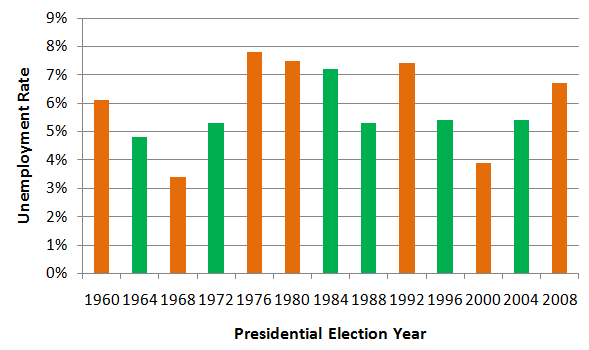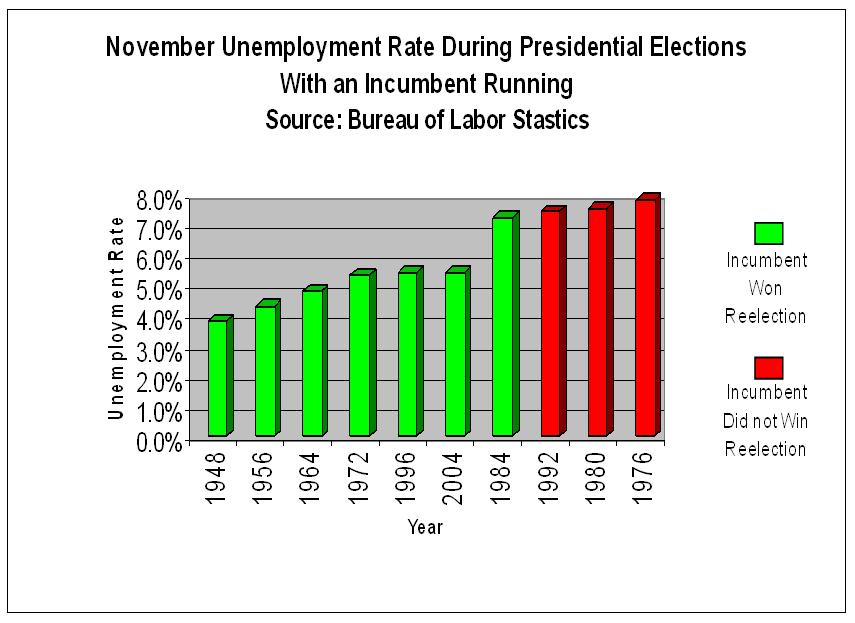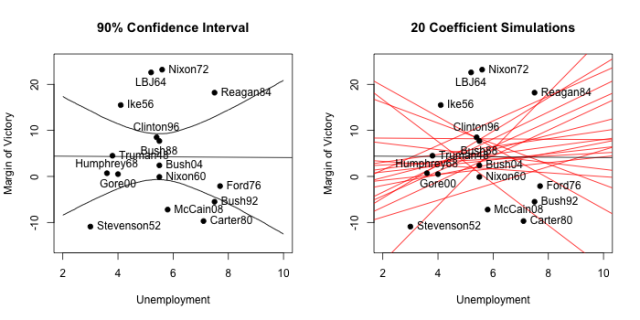Will persistent high unemployment doom Obama’s reelection chances? That question was debated anew in response to last Friday’s dismal economic report for June, which showed unemployment actually going up a tick, to 9.2% (and over 16% if one includes those who have stopped looking for work) and with the number of jobs created since May far less than what economists had predicted. The unemployment figures took on added significant in light of a much discussed NY Times article from last month which began, “No American president since Franklin Delano Roosevelt has won a second term in office when the unemployment rate on Election Day topped 7.2 percent. Seventeen months before the next election, it is increasingly clear that President Obama must defy that trend to keep his job.” Based on the Times’ article, readers might conclude that if the unemployment trends holds and recent history is a reliable guide, Obama’s reelection prospects are dim to nonexistent.
However, in the aftermath of the Times’ article and again after Friday’s report, some analysts were quick to dispute that idea. Larry Sabato, who created the widely read Crystal Ball website, noted that there was no clear relationship between unemployment and the electoral fortunes of the president’s party. As evidence, he presented the following chart:
 Green bars indicate that the incumbent president’s party won reelection while orange indicates that it went down to defeat. Based on this data, Sabato takes issue with the implications of the Times‘ piece, arguing instead that “No way is 7.2% the magic number.” As he notes, Ronald Reagan won reelection by a landslide in 1984 despite a November unemployment rate of 7.2%. Conversely, Vice President Hubert Humphrey lost his bid for the presidency in 1968 even though unemployment was only 3.4% (back when U.S. Steel was king, gas was a dime a gallon and Detroit ruled the automotive world). The reason for Humphrey’s loss is that voters were focused not on jobs but on the Vietnam War. Sabato’s broader point is that although the jobless rate is not meaningless, neither it is a foolproof predictor of election results. Indeed, it may make more sense to focus on the overall trend in unemployment numbers or changes in GDP or some other economic indicator.
Green bars indicate that the incumbent president’s party won reelection while orange indicates that it went down to defeat. Based on this data, Sabato takes issue with the implications of the Times‘ piece, arguing instead that “No way is 7.2% the magic number.” As he notes, Ronald Reagan won reelection by a landslide in 1984 despite a November unemployment rate of 7.2%. Conversely, Vice President Hubert Humphrey lost his bid for the presidency in 1968 even though unemployment was only 3.4% (back when U.S. Steel was king, gas was a dime a gallon and Detroit ruled the automotive world). The reason for Humphrey’s loss is that voters were focused not on jobs but on the Vietnam War. Sabato’s broader point is that although the jobless rate is not meaningless, neither it is a foolproof predictor of election results. Indeed, it may make more sense to focus on the overall trend in unemployment numbers or changes in GDP or some other economic indicator.
Seth Masket, another political scientist and blogger, made a similar argument on his website in the aftermath of the Times‘ article. He presented a scatterplot graphing the relationship between annual unemployment and the share of the two-party vote won by the incumbent president’s party in a presidential election. The almost flat line in the chart is a regression estimate he fit to the data indicating that there is virtually no statistical relationship between unemployment and vote share based on presidential elections dating back to 1948:
 Masket’s conclusion? “The fact is, as the above scatterplot demonstrates, the unemployment rate does not predict presidential elections at all. The Democrats failed to hold the White House in 1952 during the lowest unemployment on record. Parties have both lost and retained the White House during periods of high unemployment. And the biggest reelection margins have occurred with unemployment between five and six percent — right around the middle of its historic range.”
Masket’s conclusion? “The fact is, as the above scatterplot demonstrates, the unemployment rate does not predict presidential elections at all. The Democrats failed to hold the White House in 1952 during the lowest unemployment on record. Parties have both lost and retained the White House during periods of high unemployment. And the biggest reelection margins have occurred with unemployment between five and six percent — right around the middle of its historic range.”
Are Sabato and Masket right? Can we discount unemployment as a predictor of election results? Not necessarily. To begin, neither of them has really addressed the New York Times’ claim: that no incumbent president since FDR has won reelection with unemployment over 7.2%. Instead, they focus on the electoral fate of the incumbent president’s party. If, however, per the New York Times piece we restrict our analysis to the winner of those elections involving an incumbent, and extend our timeline back to the first post-FDR president Harry Truman in 1948, here’s what we see:
 This graphically illustrates the New York Times‘ claim. Based on this chart, it appears that if unemployment is above 9% come November, 2012, Obama is toast.
This graphically illustrates the New York Times‘ claim. Based on this chart, it appears that if unemployment is above 9% come November, 2012, Obama is toast.
Or is he? Here I want to emphasize an important point: there is a great deal of uncertainty associated with electoral projections based on 10 (or 16) data points (depending on whether we focus only on incumbents or on the incumbent’s party). Indeed, Carlisle Rainey (a political science graduate student at Florida State) estimated the 90% confidence interval surrounding Masket’s regression analysis to test Masket’s claim that unemployment rates do not predict the two-party vote share. Think of the confidence interval as a measure indicating how confident we are that the “real” relationship between vote share and unemployment falls within a specified area. So, in the first graph below, we are reasonably confident that the “true” relationship between unemployment and vote share, based on 16 data points, lies somewhere between the two curved lines.  You can see that the area between the curves is pretty substantial, meaning we aren’t really sure of the real relationship between unemployment and vote share. Even in the area of about 6% unemployment where there is the most data points there remains wide variation in the vote share won by the president’s party. Based on Rainey’s confidence interval, then, it is clear that there are many possible electoral outcomes associated with any particular level of unemployment. Indeed, as the second chart shows, Rainey suggests we can’t even be sure if the relationship is negative or positive – that is, whether an increase in unemployment decreases a party’s vote share or actually boosts it! (The upward sloping red lines in the second chart are regression simulations based on the data that indicate when unemployment goes up, so too does the incumbent party’s margin of victory – a counterintuitive finding, to be sure, but one that Rainey says we cannot discount based on 16 data points).
You can see that the area between the curves is pretty substantial, meaning we aren’t really sure of the real relationship between unemployment and vote share. Even in the area of about 6% unemployment where there is the most data points there remains wide variation in the vote share won by the president’s party. Based on Rainey’s confidence interval, then, it is clear that there are many possible electoral outcomes associated with any particular level of unemployment. Indeed, as the second chart shows, Rainey suggests we can’t even be sure if the relationship is negative or positive – that is, whether an increase in unemployment decreases a party’s vote share or actually boosts it! (The upward sloping red lines in the second chart are regression simulations based on the data that indicate when unemployment goes up, so too does the incumbent party’s margin of victory – a counterintuitive finding, to be sure, but one that Rainey says we cannot discount based on 16 data points).
What does this mean? In contrast to Masket’s confident assertion that “the unemployment rate does not predict presidential elections at all”, we actually don’t know if that’s true, at least based on the data he cites. The job rate may very well be a key factor in explaining the vote share won by the president’s party. Similarly, we can’t be sure that Sabato is correct that there is “no magic number” of unemployment above which the president will lose the election. Maybe an unemployment rate above, say, 8% really is the kiss of death for any incumbent. Sixteen or 10 data points, however, isn’t enough to make a confident projection.
This is a subtle point I’m making, but it is an important one. The jobless rate may in fact be an important determinant of the 2012 election results. In fact, I strongly believe that, all other factors being equal, the higher the unemployment rate the lower Obama’s election chances. But my estimate is based primarily on intuition and my reading of electoral history, and not on any robust statistical relationship between unemployment and previous election results. That means I could very well be wrong. Based on the data alone, about all we know with some degree of confidence is that a slight change in unemployment, say 1% up or down, is not going to have a huge impact – say, as much as plus or minus 5% in the incumbent’s share of the two party vote. Instead, the impact will be much smaller. But in a close election, even if a 1% change in unemployment shaves (or adds!) 1 or 2% in the popular vote share, it could still be decisive.
The bottom line is that whenever you read an election prediction from a pundit, you should pay attention not only to the point estimate – the margin of victory, electoral votes, etc., she projects. You should also see whether the pundit gives you any measure of the confidence she has in her prediction. It doesn’t have to be a confidence interval. Just ask her how much of her own money she’d wager on the outcome! And be sure to collect your winnings!
In that regard, I can tell you that I disagree with Masket. I think unemployment does predict presidential elections – at least those in which the incumbent is running. Fairly or not, voters hold the incumbent president (more than the incumbent party) responsible for the nation’s jobless rate, and the higher the unemployment level, the less likely the president is to be elected. I also think Obama won’t win election in 2012 with a 9.2% unemployment rate come November. I’m even willing to wager money on it. But not very much. That’s because although I’m confident that when unemployment goes up the probability of reelection go down, I can’t tell you how much the probability decreases. There’s simply too much uncertainty surrounding my estimate. That means I don’t really know if 9.2% is the kiss of death for Obama in the current climate. Maybe it’s 10.2%, or 8.2% or 7.2%. But then, I don’t think anyone else knows either. We are all basically guessing, although it is not entirely a random guess.
All is not lost, however. In a future post I’ll discuss some research that indicates other factors that may be more reliable in predicting presidential election outcomes.

Two questions:
1. How do you see the unemployment rate and the economy in general interacting with the current “brinksmanship” Republican strategy regarding the budget and the debt limit? Do you think Obama is capable of changing the public’s focus from his inability to fix the entire economy to the Republicans? And even if he can, is this change of perception enough to overcome the logic of “its the fundamentals stupid?”
2. Since FDR is the one who apparently bucked the trend, might you briefly describe how he managed to do so? Considering all the comparisons, apt or not, being drawn between the current economic unpleasantness and the Great Depression, do you see Obama being able to replicate whatever it is FDR did to take advantage of the situation?
Matt,
When you say “I strongly believe that, all other factors being equal, the higher the unemployment rate the lower Obama’s election chances”, the “all other factors being equal” leaves room enough for the 52d Airborne to march through. It seems to me that your qualifier is the ultimate fudge factor. Are “other factors” ever “all equal”?
Bob
Bob – Well, I suppose you could call it a fudge factor. I prefer to think of it as speaking precisely. If we want to forecast whether Obama will win reelection in 2012 then I suppose you are right. A lot of factors beyond unemployment that I don’t discuss will likely come into play (although, as I’ll discuss in a future post, there’s not as many as you might think; elections really turn on a few well-known “fundamentals.”) But in the narrower context of the specific post regarding whether unemployment levels, by themselves, influence election outcomes – remember, Masket says they don’t – I think I’ll stand by my choice of words. Remember, I wasn’t discussing whether Obama would win reelection per se, but instead whether, and to what degree, his reelection depends on unemployment levels. I hope that is a distinction with a difference – but maybe I’m just fudging it!
Avery – I think the debt resolution debate will almost immediately fade from public consciousness once a deal is struck, and the focus will increasingly be on jobs and the economy. Obama has to hope that he can a) remind voters that he inherited this mess and b) ask for patience to turn it around. The problem is he made missteps early on by promising too much regarding his ability to turn the economy around, and that will come back to haunt him during the campaign. And it’s not clear that he can turn the economy around. There are lots of indicators, beginning with the sluggish housing market, that suggest we are entering an extended period of very high unemployment that will resist most government-based efforts to turn this around.
Roosevelt, who came into office facing an economy in even worse shape than the current one, capitalized on a couple of factors. First, the media cycle – dominated by print news – was more forgiving which allowed him more time to turn things around. Second, by the time he ran for reelection he could point to some economic progress, even though the unemployment figures were still horrendous. In this respect he resembles Reagan. Both won landslide reelection in large part because the public liked the direction the economy was trending.